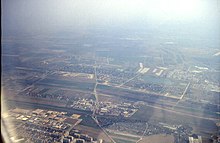Suburban settlement (Austria)
The suburban settlements are state-sponsored housing estates that were built between 1932 and 1937 as part of the marginal settlement campaign of the Christian - social- led federal government and were built by non-profit housing cooperatives and communities. Often they are or were called locally Dollfuss settlement .
history
As a result of the economic crisis in the interwar period, there was great unemployment, housing shortage and poverty in Austria. In order to counteract these circumstances, the Austrian federal government decided in 1932 to establish suburban settlements; this was continued in the corporate state . A total of 340 settlements had emerged across Austria by 1937. The largest settlements are in Vienna , but those in Graz , Linz , Klagenfurt , Salzburg and St. Pölten were more important .
From a political point of view, this action was also a counter-model of the Christian Socials to the community building system of Red Vienna . Primarily for the unemployed and short-time workers, especially families with many children, a sustainable improvement in their social situation should be created through extensive self-sufficiency, similar to a cottage owner . This was also borne by the Christian social idea of helping people to help themselves. This model provided for the acquisition of home and real estate, which is accomplished through personal work in building a house (robot) and long-term, repayable financial aid, subsidized loans, with a term of up to 40 years.
In terms of architecture, these settlements, unlike other single-family housing estates, are characterized by a uniform appearance and are therefore usually perceived as an ensemble. Some of these houses were made of wood.
Today, some suburban settlements are threatened by densification and demolition, as there is little interest in maintaining these building ensembles on the political and historical side.
Suburban settlements in detail
Dornbirn
Settlement Birkenwiese (Dollfußsiedlung) settlement in Forach , settlement in Porst
Graz
In Graz , in the district of Gries, there is a suburban housing estate in the Amselgasse / Adalbert-Stifter-Gasse area, which was planned by the secessionist Eugen Székely . This is still preserved today.
innsbruck
Sieglanger Siedlung (Dollfußsiedlung)
Linz
In Linz, the largest suburban settlements were built in St. Peter / Zizlau , as well as in Scharlinz-Wasserwald and Schörgenhub-Hütterland.
- St. Peter / Zizlau
The largest settlements on the outskirts of Linz emerged in the former district of St. Peter, which were built in different locations according to plans by Hans Arndt , Isidor Demant and Paul Theer , away from the center of St. Peter , so there was the Ing.-Demant-Siedlung Neue Welt, the settlement the Christian workers and employees in the east of the Western Railway (approximately at the level of Scharlinz / Wahringerstraße), the Ing.-Demant-Siedlung Kleinmünchen and the Dr.-Jungwirth-Siedlung further south, also in the east of the Western Railway. Few of the latter's houses in Strattnerstrasse and Gaisbergerstrasse have survived. All other buildings were demolished from 1938 by the National Socialists in the course of the establishment of the Hermann-Göring-Werke ( VÖEST ), and people were forcibly relocated to other parts of the city.
- Scharlinz water forest
In the area of Salzburger Strasse / Lißfeldstrasse / Brunnenfeldstrasse there is a suburban settlement that is still partially preserved. This should not be confused with the row house settlement built by Curt Kühne in 1920 on Haydnstrasse.
- Outskirts settlement Schörgenhub (Hütterland)
The settlement was planned by the architect Hans Arndt . In the Dauphinestraße / Im Hütterland / Am Steinbühel area, the settlement has largely been preserved.
Salzburg
The Kendlersiedlung (Engelbert-Dollfuss-Siedlung) was built in Maxglan . Further suburban settlements were built in Hallwang and Itzling.
St. Polten
The Dollfußsiedlung (Teufelhof / Heimstättenstraße) with more than 200 houses was built in St. Pölten in 1933/35 as the largest suburb outside of Vienna.
Vienna
- Aspern
This settlement Mittleres Hausfeld / An den alten Schanzen, built in 1934 under the Christian Social Mayor Richard Schmitz , was planned by the architect Richard Bauer (born 1897), partly with Johann Franz Würzl .
- Breitenlee
Built in 1934 according to plans by Hermann Stiegholzer and Herbert Kastinger in the area of Breitenleer Straße / Ziegelhofstraße / Rautenweg.
- Hirschstetten
The simple wooden houses were built in 1934/35 by the architect J. Proksch in the area of Plankenmaisstraße / Rittersporngasse / Hyazinthengasse.
- Leopoldau
The first settlement built in 1932 according to plans by Richard Bauer in the area of Triestinggasse / Schererstraße / Oswald-Redlich-Gasse was built in Leopoldau. In 1934/35 it was expanded to include the northern border settlement. Today only a few original houses are preserved.
criticism
This form of social housing was criticized by the Social Democrats, who saw suburban settlements as completely inadequate and, for their part, pushed for the construction of workers' rented apartment blocks as community buildings .
See also
literature
- Manfred Carrington , Andreas Reiter , Günter Kaar : LiNZ contemporary history - from provincial to steel town, the beginning of VÖEST. Lentia-Verlag, Linz 2012, ISBN 978-3-9503469-0-9 .
- Andreas Suttner : Black Vienna. Construction activity in the corporate state 1934–1938 . Böhlau, Vienna 2017, ISBN 978-3-205-20292-9 ( oapen.org [accessed February 15, 2019]).
Web links
- Historical suburban settlement from the 1930s threatened by densification. Architektur Steiermark, www.gat.st (accessed on December 16, 2017)
- Oliver Koch: Workers' estate as a symbol for a pioneering social project. , www.mein Bezirk.at (accessed on December 16, 2017)
Individual evidence
- ↑ Sieglanger settlement, history
- ^ Julius Schulte : Julius Schulte and his students. Innsbruck / Linz 1933, p. 74 f. ( digital )
- ^ Richard Bauer (born November 24, 1897 in Vienna; died after 1938) , on Architects Lexicon Vienna 1770–1945



